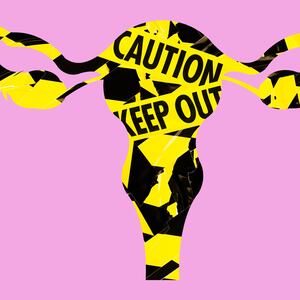The coat hanger wire had been sharpened at one end and was stained with the blood of an 18-year-old Alabama high school cheerleader who died in an illegal abortion just before football season in 1953.
Her name was Elsie Leola Bodiford and she was from tiny Frisco City, nine miles from Monroeville, hometown of author Harper Lee and setting of To Kill a Mockingbird.
As reported in extensive newspaper accounts of the subsequent prosecution, the fatal effort to terminate Bodiford’s pregnancy was arranged by her high school’s 25-year-old football coach, William Henry Hamilton. He enlisted a friend and the friend’s brother to help him avoid a career-ending scandal. All three men were arrested. The instrument of death was entered into evidence.
ADVERTISEMENT
“You hang a shirt and all on it,” a former classmate named David Ikner remarked to the Daily Beast when asked about the case. “It’s a piece of wire. That’s all it is. They went up through her womb with it.”
He was speaking of a coat hanger such as became a symbol of a benighted past. Such as threatens to return now that the state where Bodiford briefly lived and has long been buried has enacted a near-total abortion ban as part of a scheme to overturn Roe v. Wade.
If the new Alabama law is not struck down by the courts, abortion will become a felony there, just as it was in 1953, when a football coach began taking advantage of a vulnerable cheerleader. Bodiford’s mother had died in April, four agonizing months after being critically burned when somebody was so stupid as to throw gasoline on a fire. The high-schooler Bodiford was no doubt grieving and vulnerable, easy prey when Coach Hamilton began taking her to a fishing camp early that summer.
As told by prosecutors, Hamilton had sex with her there on repeated occasions. She soon was pregnant.
Hamilton urged her to avoid scandal by quickly marrying one of the local young men. But she refused to embark on a lifelong lie about the baby’s father.
In early July, Hamilton went to a shoe shop run by his close friend, 34-year-old Alton Johnson. The coach confided in Alton, telling him about the pregnancy and saying he would be “ruined for life” if it became known. Hamilton told his friend about pushing Bodiford to marry somebody. He also reported that he had the girl take a purgative of some kind, but it had not been effective.
In early August, Hamilton later testified and the press widely reported, he again sought out Alton, saying that the matter was becoming ever more urgent because the new school year would be starting soon.
Not long afterward, Alton encountered his 31-year-old brother Harold at a birthday celebration for their mother and told him he had “a friend in trouble.” Harold was a food salesman, but police and prosecutors came to believe he had started a new line of work.
Sometime between 6 a.m. and 7 a.m. on Aug. 26, 1953, William Bodiford saw his daughter leaving the house. She told him she was heading to see a girlfriend who lived several miles away. He would testify that he had no idea she was pregnant.
At 9 p.m., Elsie Bodiford boarded a bus. She got off at Atmore, where Alton had told her to meet him when he went by her house the day before. She got in Alton’s car and he drove her across the state line to the the Coffee Cup diner in Pensacola. They set off in two cars.
In East Pensacola Heights, they pulled into a tourist court off Route 90 called Hood’s Cottages. Harold rented Cabin 21 in his name and entered it with Bodiford. He arranged for a porter to deliver a Coca-Cola and a beer.
Alton went into the Hood’s Cottages cafe. He was having a sandwich and a soda when Harold's car roared up, the horn blaring.
The car sped off with Harold and Alton in the front, Bodiford unconscious and bleeding in the back. They stopped to ask a woman for the location of the nearest emergency room. She directed them to Sacred Heart Hospital.
Two apprentice morticians happened to be by the entrance when Harold drove up. They carried Bodiford inside, where a doctor tried to revive her. She was pronounced dead.
After she was fingerprinted, an autopsy was conducted. The coroner concurred with the attending physician that Bodiford had died as a result of a sharp object piercing her womb, causing air to enter her bloodstream. They would also concur that it would have been physically all but impossible and prohibitively painful for the wound to have been self-inflicted.
In the meantime, Alton had slipped away and returned to Frisco City, where he sought out the coach to tell him Bodiford was dead. Harold was interviewed by the sheriff and at first said he had been driving on Route 90 when he saw a girl hitchhiking. He said he picked her up because it had started to rain, but had driven no more than 100 yards when she cried out something and her head fell back against the seat.
Harold’s version began to unravel after a maid entered Cabin 21 to find blood on the sheets and four towels, as well as on a bedside table and a wall. She also discovered a bloodstained length of wire.
When confronted by the sheriff, Harold admitted driving Bodisford to Hood’s tourist court and offered a version he would largely stick to during the future trials.
He now allowed that he had been inside Cabin 21 with Bodiford but insisted she had asked him to leave. He said he had complied and had been sitting outside in his car when he heard “moaning sounds,” at which time he entered to find her curled up on the bed and unresponsive. He told the sheriff her panties had been on the floor and he had put them back on her before carrying her to his car and taking her to the hospital.
The sheriff responded by arresting Harold for manslaughter. Alton was arrested as an accessory after witnesses at the tourist court identified both brothers.
Hamilton was also charged and pleaded guilty just before the trial and took stand against the Johnsons. He testified that he did not feel responsible for Bodiford’s fate, as he could not be absolutely sure he was the father.
The coat hanger wire was entered into evidence. Alton denied the prosecutor’s suggestion that the instrument of Bodiford’s death had been sharpened with a shoe sander in his shop. Harold continued to insist that he left her alone. The defense suggested she must have performed the abortion on herself.
The jury convicted Harold of murder in the third degree for having wielded the sharpened wire. He was sentenced to 12 years. Alton and Hamilton each got seven years as accessories.
But the conviction of the brothers was vacated because they had in fact been charged in connection with the lesser crime of manslaughter. They were retried but the judge declared a mistrial after the jury deadlocked. The Johnsons were tried yet again and this time acquitted, jurors this time buying Harold’s version.
Alton died in 2003. Harold would now be 97. He could not be reached for comment.
Hamilton was pardoned without serving a minute of his sentence. He moved with his school-teacher wife, Ellen Hamilton, to Camden, which was by chance the hometown of Gov. Kay Ivey, who just signed Alabama’s abortion ban into law. He also could not be reached for comment.
Elsie Leora Bodiford was buried in Shiloh Primitive Baptist Church. The inscription reads, “Peace & Rest Unto Thee.”
Surviving schoolmates from Frisco City High School recall that all the boys in her class of 28 served as pallbearers.
“The car got full and I got left out,” J.W. Bailey told the Daily Beast last week. “So they put me in the front of the hearse with the driver.”
Bailey, who was then 17, remembers Bodiford as “a happy, outgoing person.”
“A regular teenage high school girl,” he said.
He recalled that fall practice had started for the football team, which had such a small roster everybody had to play offense and defense. Bodiford would have soon appeared at her first game as a cheerleader.
“She didn’t make it,” Bailey noted.
He said her death shook the farming town of 1,200.
“It was devastating,” he recalled.
Her classmate Ikner said, “In my opinion, she was a good person... She got involved with the wrong person.”
Bailey and Ikner are anti-abortion despite the memory of their classmate’s death before her life really began. Bailey allows that the new ban in Alabama went too far by including pregnancies resulting from rape or incest.
But both men are manifestly decent people and would be the first to agree that Bodiford’s death was a tragedy that shouldn’t have been. Their own decades of family and career since high school remain a measure of what she lost.
Bodiford herself would almost certainly tell us that she should have had a choice regarding her own body that did not entail her losing her life.
The fatal coat hanger was discarded after it was no longer needed as evidence. Coat hangers seemed on the way to becoming a symbol of darker times gone after the U.S. Supreme Court Court handed down Roe v. Wade in 1973.
But now the past threatens to become future and the tale of Elsie Leora Bodiford and the coat hanger is one to remember.







